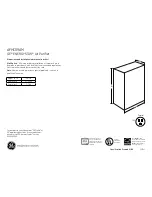
6
General Information (Continued)
Unit Nameplate
One Mylar unit nameplate is located on the outside upper
left corner of the control panel door. It includes the unit
model number, serial number, electrical characteristics,
weight, refrigerant charge, as well as other pertinent unit
data. A small metal nameplate with the Model Number, Se-
rial Number, and Unit Weight is located just above the Mylar
nameplate, and a third nameplate is located on the inside of
the control panel door.
Compressor Nameplate
The Nameplate for the Scroll Compressor is located on the
compressor lower housing.
Hazard Identification
WARNING
– Indicates a potentially hazardous
situation which, if not avoided, could result in death or
serious injury.
CAUTION
– Indicates a potentially hazardous
situation which, if not avoided, may result in minor or
moderate injury. It may also be used to alert against
unsafe practices.
WARNING
Fiberglass Wool
Product contains fiberglass wool. Disturbing the insula-
tion in this product during installation, maintenance or
repair will expose you to airborne particles of glass
wool fibers and ceramic fibers known to the state of
California to cause cancer through inhalation. Glass
wool fibers may also cause respiratory, skin or eye irri-
tation.
Precautionary Measures
-
Avoid breathing fiberglass dust.
-
Use a NIOSH approved dust/mist respirator.
-
Avoid contact with the skin or eyes. Wear long-
sleeved, loose-fitting clothing, gloves, and eye
protection.
-
Wash clothes separately from other clothing:
rinse washer thoroughly.
-
Operations such as sawing, blowing, tear-out, and
spraying may generate fiber concentrations requiring
additional respiratory protection. Use the appropriate
NIOSH approved respiration in these situations.
First Aid Measures
Eye Contact -
Flush eyes with water to remove
dust. If symptoms persist, seek medical attention.
Skin Contact -
Wash affected areas gently with soap
and warm water after handling.
Commonly Used Acronyms
For convenience, a number of acronyms and abbreviations
are used throughout this manual. These acronyms are al-
phabetically listed and defined below.
BAS = Building automation systems
CFM = Cubic-feet-per-minute
CKT. = Circuit
CV = Constant volume
CW = Clockwise
CCW = Counterclockwise
E/A = Exhaust air
ECEM = Exhaust/comparative enthalpy module
F/A = Fresh air
GBAS = Generic building automation system
HGBP = Hot gas bypass
HI = Human Interface
HVAC = Heating, ventilation and air conditioning
IGV = Inlet guide vanes
I/O = Inputs/outputs
IOM = Installation/operation/ maintenance manual
IPC = Interprocessor communications
IPCB = Interprocessor communications bridge
LCI-I = LonTalk Communication Interface for IntelliPak
LH = Left-hand
MCM = Multiple compressor module
MWU = Morning warm-up
NSB = Night setback
O/A = Outside air
psig = Pounds-per-square-inch, gauge pressure
R/A = Return air
RH = Right-hand
RPM = Revolutions-per-minute
RT = Rooftop unit
RTM = Rooftop module
S/A = Supply air
SCM = Single circuit module
SZ = Single-zone (unit airflow)
TCI = Tracer communications module
UCM = Unit control modules
VAV = Variable air volume
VCM = Ventilation control module
VOM = Ventilation override module
w.c. = Water column
Unit Description
Each Trane commercial, single-zone rooftop air conditioner
ships fully assembled and charged with the proper refriger-
ant quantity from the factory.
An optional roof curb, specifically designed for the S_HF
and S_HG units is available from Trane. The roof curb kit
must be field assembled and installed according to the lat-
est edition of SAHF-IN-5 or SXHG-IN-2 respectively.
Trane Commercial Rooftop Units are controlled by a micro-
electronic control system that consists of a network of mod-
ules and are referred to as Unit Control Modules (UCM).
The acronym UCM is used extensively throughout this
document when referring to the control system network.
These modules through Proportional/Integral control algo-
rithms perform specific unit functions which provide the best
possible comfort level for the customer.
They are mounted in the control panel and are factory
wired to their respective internal components. They receive
and interpret information from other unit modules, sensors,
remote panels, and customer binary contacts to satisfy the
applicable request for economizing, mechanical cooling,
heating, and ventilation. Refer to the following discussion for
an explanation of each module function.
Содержание INTELLIPAK RT-SVX10C-EN
Страница 16: ...15 Figure 3 1 Minimum Operation and Service Clearances for Single Multiple Unit Installation...
Страница 17: ...16 Figure 3 2A SAHF Cooling Only Units 20 thru 75 Ton...
Страница 19: ...18 Figure 3 2B SEHF SFHF SLHF SSHF SXHF Units 20 thru 75 Ton...
Страница 21: ...20 Figure 3 2C S_HG Cooling Heating Units 90 through 130 Ton...
Страница 25: ...24 Figure 3 4 Typical Unit Rigging Figure 3 5 Unit Base Roof Curb Section...
Страница 38: ...37 Figure 3 13 Steam Coil Piping 20 through 30 Ton Units Steam Coil Piping 40 through 130 Ton Units...
Страница 41: ...40 Figure 3 14 Continued Typical Field Power Wiring 90 thru 130 Ton Table 3 6 Customer Connection Wire Range...
Страница 52: ...51 Field Connection Diagram Notes for 20 through 130 Ton CV or VAV Applications...
Страница 86: ...84 Figure 4 6 Compressor Locations...
Страница 103: ...101 Service Maintenance Continued Table 5 3 Unit Internal Fuse Replacement Data VFD Factory Settings...
Страница 117: ...115...
Страница 118: ...116...







































